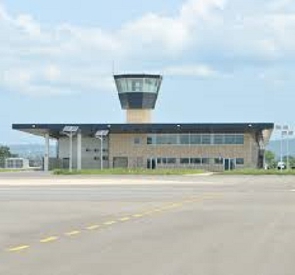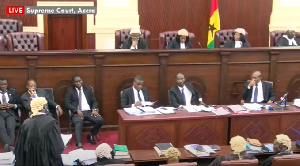Opinions of Saturday, 9 September 2023
Columnist: Joel Degue
Ho Airport in Volta Region: A misplaced priority
On September 18, 2015, John Dramani Mahama held a colourful groundbreaking ceremony for Ho Airport as the fulfillment of a campaign promise to the people of Volta Region, the NDC Party's World Bank so far as electoral votes are concerned.
All the same, the region has not received the needed infrastructure and other investments for its socio-economic development. A situation that has made many people in the region disappointed in the party and apathetic towards voting for the party as seen in the last two elections. Finally, there came the hope to make one big investment in the region, probably the biggest, the building of an airport, the Ho Airport.
The cost of construction was estimated to be $ 25 million, provided by Ghana Airports Company Limited. Construction was completed in 2017, although the airport was not opened to commercial traffic until 2021. There were only about 20 commercial flights that plied the Accra-Ho route and only about 350 passengers travelled along that route. The two airlines that carried passengers were Passion Air and Africa World Airlines (AWA). Flights to the Ho Airport ended shortly thereafter because, according to the airlines, it did not make economic sense.
The big question people asked at the very beginning when the election pledge was made in the 2012 campaign was this: Was any cost-benefit analysis done? Did it make economic sense to build a commercial airport at Ho?
A misplaced priority
In the heart of the Volta Region in Ghana, a striking symbol of misplaced priorities stands tall: the Ho Airport. Built at a staggering cost of $25 million, this airport was touted as a game-changer for the region, promising improved connectivity, socio-economic development, and promoting tourism. However, as time has passed, it has become increasingly clear that this colossal investment could have been used far more effectively to benefit the people of the Volta Region holistically.
Arguments for the airport
The proponents of the Ho Airport argued that it would boost tourism and bring in trade and investment in the region, thus stimulating socio-economic growth. Yet, the reality on the ground, six good years after its completion, paints a different picture, a very gloomy one.
Arguments against the airport
A commercial airport in 2012 was not a top priority for the Volta Region. No, it couldn't be. People held different views since that election promise was made in 2012. And today, they have been vindicated, therefore I write this piece to remind people in the region once again, especially as we approach another crucial election in December 2024.
Major priority investment areas in Volta Region
The $25 million invested in this airport could have been utilized in great productive ways that would have had far-reaching and sustainable impacts on the region's economy. One undeniable fact is that the Volta Region, like many other areas in Ghana, faces severe unemployment challenges, especially youth and graduate unemployment. The youth in the region are crying out for opportunities, and this is where the misplacement of priorities becomes painfully evident.
As a development consultant, I know what the key priority areas are for investment in the region. I know the productive sectors that could be the game-changers for the rapid and sustainable socio-economic transformation of the region. Instead of constructing an airport at such a high cost, which primarily benefits a limited number of rich travelers, that $ 25 million could have been channeled into creating about eight small factories. These factories could have been built in strategic areas like Bomigo in the Anloga District to add value to the several million metric cubes of special clay for ceramics, tiles, and basins abundant in the area, a kente weaving factory and training centre at Agbozume, a ginger transformation factory at Hohoe, a coconut plantation and processing factory at Akame in Keta South, a tilapia farm at Kpeve or Kpando Torkor, cassava farms and a gari/starch processing plant at Ehi to serve other areas too in Ketu North, a rice milling plant at Afife or Dekpor, or palm farms and oil extraction plant at Dzodze, a tomato processing factory at Anloga or Ziope, etc, etc.
These factories could have produced a wide range of agricultural produce, finished or semi-finished products from textiles to agro-processed food items, tiles, and porcelain products, providing jobs for hundreds if not thousands of people in and outside the region. The resulting increase in local production and consumption would have a far more significant and lasting impact on the economy of the Volta Region than an airport, a capital investment with less socio-economic impact.
Furthermore, the funds could have been allocated towards developing approximately four tourist destinations: southern (Beach and Coastal), Central (Hills and Mountains), Northern (Volta Lake) Circuits, and the Oti Destination. At least 2 -3 tourist attractions would have been developed in each district to meet international standards and then be aggressively promoted and marketed to the world. This alone would have positioned and branded the Volta Region as one of the best tourism destinations in Ghana and West Africa, attracting a huge number of both local and foreign tourists to the region.
This approach would not only have provided employment opportunities for the youth in the hospitality industry but also strengthened the region's tourism sector. With the right support and infrastructure, agriculture and tourism alone have the potential to be major drivers of socio-economic transformation and growth in the Volta Region.
Moreover, the $25 million could have been invested in creating two industrial zones or technology parks in the region. These zones could have attracted all kinds of industries and harnessed the natural resources of the Volta Region, facilitating entrepreneurship, value addition, and innovation. This would have laid an industrial base to attract tech, fintech, and other innovative businesses, both local and foreign, fostering the spirit of entrepreneurship, creativity, innovation, and industrialization.
Now a white elephant
In retrospect, it's clear that the Ho Airport project has become a white elephant since its completion in 2017. The promised socio-economic transformation the airport would bring to the Volta Region has not materialized. The airport primarily was meant to serve the interests of those who can afford air travel, while the majority of the region's population remains mired in poverty, unemployment, and lack of opportunities. The airport was a good capital project but a very bad economic investment.
The 1,500 acres (about 610 hectares) of land delineated for the airport at the colossal amount of $ 25 million could be a shining project by now as said at the beginning: Volta Region Industrial Zone (VRIZ), an "Agricole" or a "technopole" that could be growth poles in Volta Region. But alas, the airport finally became a misplaced priority and now remains a white elephant.
Conclusion:
In conclusion, the construction of the Ho Airport in the Volta Region was indeed a misplaced priority. The $25 million investment could have been used to create jobs, stimulate economic growth, and reduce poverty through initiatives such as small factories and plants, agricultural farms, industrial zones, or technology parks.
It's time for a serious re-evaluation of the region's development priorities to ensure that investments truly benefit the people and lead to sustainable development. As the time for manifesto writing inches, let's all be wary of the promises once again.













